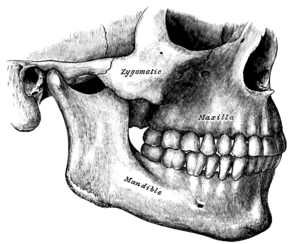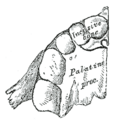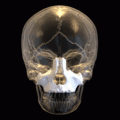Maxilla facts for kids
The maxilla is the bone that forms your upper jaw. It holds your upper teeth in place. In humans and other mammals, this bone is tightly connected to the rest of the skull. However, in animals like fish and reptiles, the maxilla can often move more freely. For example, a snake's maxilla can move a lot, allowing its jaws to open very wide to swallow large prey.
Contents
What the Maxilla Does
The maxilla has several important jobs in your head.
- Holds Teeth: The lower part of the maxilla, called the alveolar process, holds all your upper teeth. This area is sometimes called the maxillary arch.
- Connects to Cheekbones: Each maxilla bone connects to your zygomatic bones, which are your cheekbones.
- Forms Parts of Your Face: The maxilla helps create the boundaries of three important areas:
* The roof of your mouth. * The floor and side walls of your nasal cavity (inside your nose). * Part of the wall around your eye socket.
The Maxilla in Different Animals
The maxilla can look very different in various animals.
Upper and Lower Jaws
Sometimes, especially in bony fish, the maxilla is called the "upper maxilla." The lower jaw bone is then called the "lower maxilla." But in birds, the upper jaw is often called the "upper mandible."
Premaxilla Bone
In most animals with backbones, the very front part of the upper jaw is made of a separate pair of bones called the premaxillae. In mammals, these premaxillae usually join with the main maxilla bone to form one solid bone, like in humans.
- Fish, Amphibians, and Reptiles: In bony fish, amphibians, and reptiles, both the maxilla and premaxilla are flatter bones. They form the sides of the upper jaw and part of the face. The premaxilla also forms the bottom edge of the nostrils.
- Mammals: In mammals, these bones have curved inward. This creates a part called the palatine process, which helps form part of the roof of the mouth.
Birds and Sharks
- Birds: Birds do not have a maxilla in the same way other animals do. The main part of their beak (which is mostly made of the premaxilla) is called the "upper mandible."
- Sharks: Cartilaginous fish, like sharks, do not have a true maxilla bone. Their upper jaw is made from a cartilaginous bar. This bar is not the same as the bone found in other animals with backbones.
Images for kids
See also
 In Spanish: Maxilar para niños
In Spanish: Maxilar para niños







